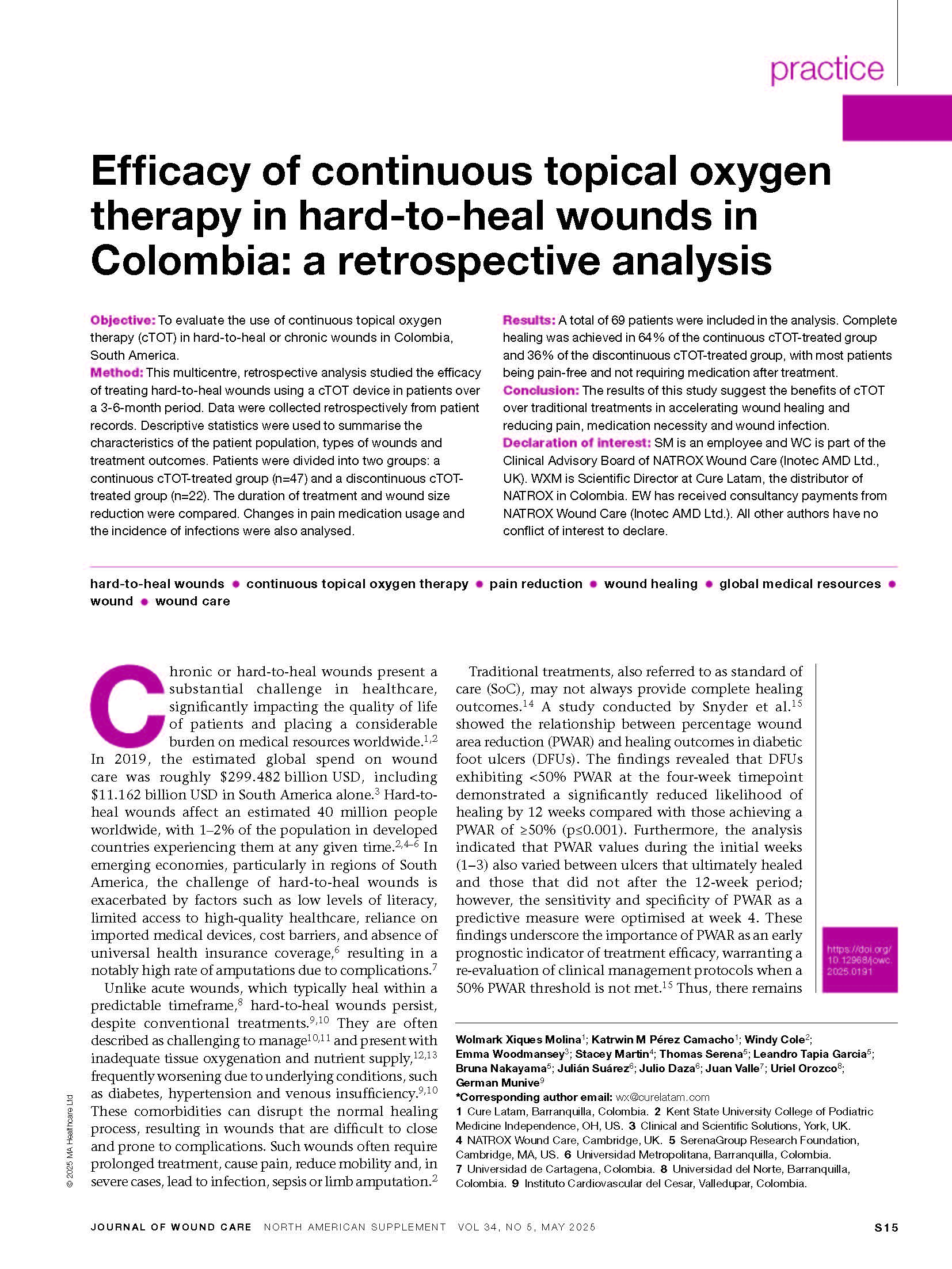Topical Oxygen Therapy in the Management of Hard-to-Heal Wounds in Colombia: A Retrospective Review

Journal of Wound Care Article
This multicentre, retrospective analysis studied the efficacy of treating hard-to-heal wounds using a cTOT device in patients over a 3-6-month period. Data were collected retrospectively from patient records. Descriptive statistics were used to summarise the characteristics of the patient population, types of wounds and treatment outcomes. Patients were divided into two groups: a continuous cTOT-treated group (n=47) and a discontinuous cTOT treated group (n=22). The duration of treatment and wound size reduction were compared. Changes in pain medication usage and the incidence of infections were also analysed.
Title: Efficacy of continuous topical oxygen therapy in hard-to-heal wounds in Colombia: a retrospective analysis
Authors: Wolmark Xiques Molina; Katrwin M Pérez Camacho; Windy Cole; Emma Woodmansey; Stacey Martin; Thomas Serena; Leandro Tapia Garcia; Bruna Nakayama; Julián Suárez; Julio Daza; Juan Valle; Uriel Orozco; German Munive
Published in: Journal of Wound Care, NORTH AMERICAN SUPPLEMENT VOL 34 May 2025
Keywords: Hard-to-heal Wounds, Continuous Topical Oxygen Therapy, Pain Reduction, Wound Healing, Global Medical Resources, Wound, Wound Care
Introduction
- Hard-to-heal wounds pose a significant challenge in healthcare, affecting the quality of life of an estimated 40 million patients worldwide.
- The management of these wounds strains limited medical resources. In 2019, the global expenditure on wound care was estimated at approximately 299.4819 billion USD, with South America alone contributing 11.1619 billion USD.
- Developing regions like the nations in South America have a higher number of nonhealing wounds due to limited healthcare access and financial barriers.
- When conventional treatments fail, alternative therapies such as Continuous Topical Oxygen Therapy (cTOT) are needed. cTOT enhances the wound healing process.
- This retrospective study evaluated the real-world efficacy of treating hard-to-heal wounds using a cTOT device in 69 patients over a three-to-six-month period.

Results/Discussion
- While cTOT has been proven effective in supporting more rapid wound closure in a variety of wound types worldwide, this trial is the first cohort study to examine the effects of cTOT on a population of patients in Colombia.
- This study assessed the efficacy of continuous and discontinuous cTOT with both groups exhibiting more favorable wound outcomes than with previous standard of care therapies.
- However, the patients receiving continuous cTOT illustrated notably faster healing with a greater proportion of patients achieving complete wound closure compared to the discontinuous cTOT group (64% vs. 36%).
- This concurs with previous studies on both DFU and VU where complete healing was achieved in 44.4% and 40% respectively.
- Additionally, in this study, treatment duration was significantly longer for patients in the discontinuous cTOT group, with a p-value of 0.000015. This trend was especially pronounced among patients with diabetic foot ulcers (DFUs), although the sample size for other wound types was insufficient for a definitive comparison.
- Both treatment groups experienced significant wound size reductions, indicating the overall effectiveness of the cTOT therapy.
- However, patients who received continuous cTOT showed a significantly higher percentage of wound area reduction (PWAR) per week than those receiving discontinuous cTOT.
- This impact on healing concurs with previous data, including level 1 evidence from RCTs and meta-analyses, and has been recognized by inclusion in various international guidance for treatment of non-healing wounds.
Authors:
Windy Cole, DPM, Wolmark Xiques Molina, MD, Katrwin Melissa Pérez Camacho, Thomas Serena, MD